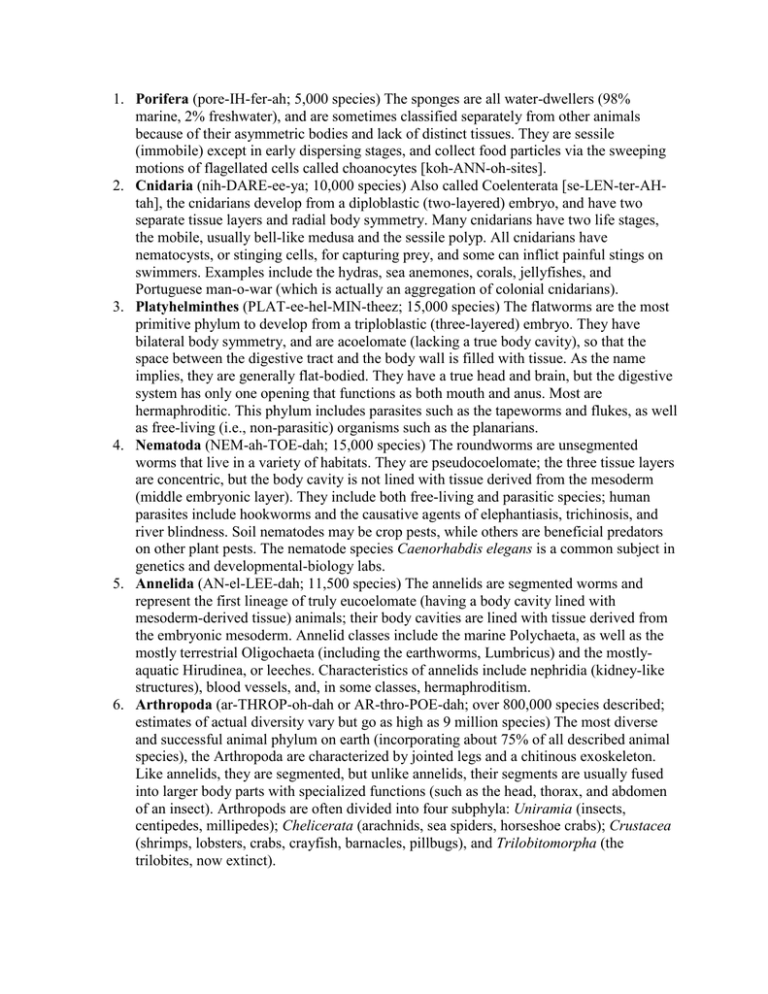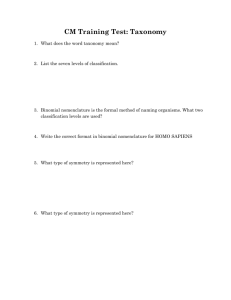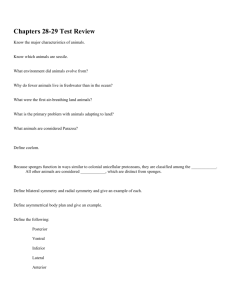Porifera marine, 2% freshwater), and are sometimes classified separately from other... because of their asymmetric bodies and lack of distinct tissues....
advertisement

1. Porifera (pore-IH-fer-ah; 5,000 species) The sponges are all water-dwellers (98% marine, 2% freshwater), and are sometimes classified separately from other animals because of their asymmetric bodies and lack of distinct tissues. They are sessile (immobile) except in early dispersing stages, and collect food particles via the sweeping motions of flagellated cells called choanocytes [koh-ANN-oh-sites]. 2. Cnidaria (nih-DARE-ee-ya; 10,000 species) Also called Coelenterata [se-LEN-ter-AHtah], the cnidarians develop from a diploblastic (two-layered) embryo, and have two separate tissue layers and radial body symmetry. Many cnidarians have two life stages, the mobile, usually bell-like medusa and the sessile polyp. All cnidarians have nematocysts, or stinging cells, for capturing prey, and some can inflict painful stings on swimmers. Examples include the hydras, sea anemones, corals, jellyfishes, and Portuguese man-o-war (which is actually an aggregation of colonial cnidarians). 3. Platyhelminthes (PLAT-ee-hel-MIN-theez; 15,000 species) The flatworms are the most primitive phylum to develop from a triploblastic (three-layered) embryo. They have bilateral body symmetry, and are acoelomate (lacking a true body cavity), so that the space between the digestive tract and the body wall is filled with tissue. As the name implies, they are generally flat-bodied. They have a true head and brain, but the digestive system has only one opening that functions as both mouth and anus. Most are hermaphroditic. This phylum includes parasites such as the tapeworms and flukes, as well as free-living (i.e., non-parasitic) organisms such as the planarians. 4. Nematoda (NEM-ah-TOE-dah; 15,000 species) The roundworms are unsegmented worms that live in a variety of habitats. They are pseudocoelomate; the three tissue layers are concentric, but the body cavity is not lined with tissue derived from the mesoderm (middle embryonic layer). They include both free-living and parasitic species; human parasites include hookworms and the causative agents of elephantiasis, trichinosis, and river blindness. Soil nematodes may be crop pests, while others are beneficial predators on other plant pests. The nematode species Caenorhabdis elegans is a common subject in genetics and developmental-biology labs. 5. Annelida (AN-el-LEE-dah; 11,500 species) The annelids are segmented worms and represent the first lineage of truly eucoelomate (having a body cavity lined with mesoderm-derived tissue) animals; their body cavities are lined with tissue derived from the embryonic mesoderm. Annelid classes include the marine Polychaeta, as well as the mostly terrestrial Oligochaeta (including the earthworms, Lumbricus) and the mostlyaquatic Hirudinea, or leeches. Characteristics of annelids include nephridia (kidney-like structures), blood vessels, and, in some classes, hermaphroditism. 6. Arthropoda (ar-THROP-oh-dah or AR-thro-POE-dah; over 800,000 species described; estimates of actual diversity vary but go as high as 9 million species) The most diverse and successful animal phylum on earth (incorporating about 75% of all described animal species), the Arthropoda are characterized by jointed legs and a chitinous exoskeleton. Like annelids, they are segmented, but unlike annelids, their segments are usually fused into larger body parts with specialized functions (such as the head, thorax, and abdomen of an insect). Arthropods are often divided into four subphyla: Uniramia (insects, centipedes, millipedes); Chelicerata (arachnids, sea spiders, horseshoe crabs); Crustacea (shrimps, lobsters, crabs, crayfish, barnacles, pillbugs), and Trilobitomorpha (the trilobites, now extinct). 7. Cycliophora (CY-clee-oh-FORE-ah; 1 species) The most recently named phylum; its only known member is Symbion pandora, a tiny invertebrate first identified in 1995 when a Danish biologist found specimens on the mouthparts of a Norwegian lobster. It is believed to be closely related to the marine phyla Entoprocta and Ectoprocta (Bryozoa), which are not discussed here. 8. Mollusca (mol-LUS-kah; 50,000 species) The molluscs are second in diversity only to the arthropods. Body plans within this phylum are diverse, but general characteristics include a soft body covered by a thin mantle, with a muscular foot and an internal visceral mass. There are two fluid-filled body cavities derived from mesodermal tissue; a small coelom and a large hemocoel that functions as an open circulatory system. Many molluscs have a shell composed of calcium carbonate and proteins, secreted by the mantle. Familiar groups within the Mollusca include the classes Gastropoda (slugs, snails), Bivalvia (clams, oysters, scallops), and Cephalopoda (nautilus, squids, octopi). 9. Echinodermata (ek-KY-no-der-MAH-tah; 6,500 species) Characteristics of this phylum include an endoskeleton composed of many ossicles of calcium and magnesium carbonate, a water vascular system (WVS), a ring canal around the esophagus, and locomotion by tube feet connected to the WVS. Unique to echinoderms is the five-fold radial symmetry obvious in sea stars (seafish), sea urchins, and sea lilies. Others, like sea cucumbers, have varying degrees of bilateral symmetry. In the echinoderm body plan, a true head is absent; the anatomical terms oral (mouth-bearing) and aboral (away from the mouth) are used to describe orientation of the body surfaces. Feeding adaptations include particle feeding through the WVS, everting the stomach to engulf prey (sea stars), and a scraping device called Aristotle's lantern (sea urchins). 10. Chordata (kor-DAH-tah; 44,000 species) Our home phylum is divided into three subphyla: Urochordata, the sea squirts; Cephalochordata, the lancelets, and the true vertebrates (Vertebrata, the most diverse subphylum). Defining traits of chordates include pharyngeal gill slits, a notochord, a post-anal tail, and a dorsal hollow nerve cord. In vertebrates, some of these structures are found only in embryonic stages. The lancelet Amphioxus (Branchiostoma) is often used as a demonstration organism in biology labs.




